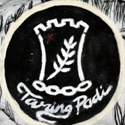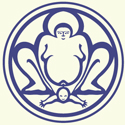In the era of computer graphics, ancient graphic techniques come as a pleasant surprise.
“What you see is what you get” may not sound that interesting. But the results of these graphic prints can be a happy surprise.
Happiness was the general feeling throughout the wood cut workshop with Jogja’s art collective Taring Padi at Taman 65 in Kesiman, Denpasar, on October 8th. The workshop participants looked so happy, especially when lifting a woodcut print from their own t-shirt or piece of paper.
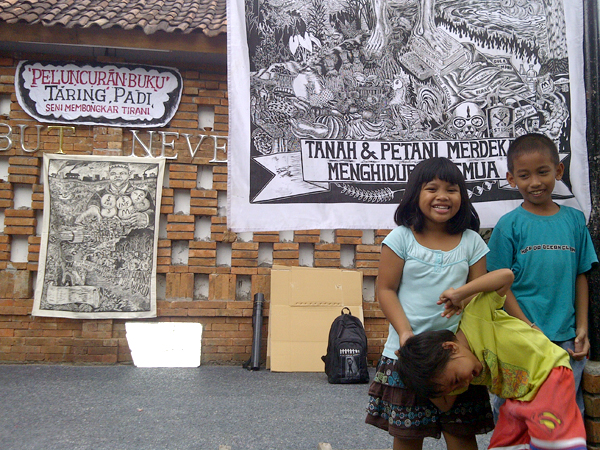 Happy surprise was the expression most people displayed when they first saw the results of their woodcut prints. Even though the prints were monochrome created with only black ink. But the the results were not so predictable: One print on two different shirts could be very different, depending on the thickness of the paint upon the woodcut surface. The method of pressing the woodcut upon the medium of cloth or paper also impacted the resulting artwork.
Happy surprise was the expression most people displayed when they first saw the results of their woodcut prints. Even though the prints were monochrome created with only black ink. But the the results were not so predictable: One print on two different shirts could be very different, depending on the thickness of the paint upon the woodcut surface. The method of pressing the woodcut upon the medium of cloth or paper also impacted the resulting artwork.
The woodcut leaves an impression on paper or cloth by pressure placed firmly on top of it. In this case, participants tread or jumped on their woodcuts. If you don’t step long enough, the paint may be too thin or the image unclear because some sections of the media are not pressed as hard as others.
 The woodcut leaves an impression on paper or cloth by pressure placed firmly on top of it. In this case, participants tread or jumped on their woodcuts. If you don’t step long enough, the paint may be too thin or the image unclear because some sections of the media are not pressed as hard as others.
The woodcut leaves an impression on paper or cloth by pressure placed firmly on top of it. In this case, participants tread or jumped on their woodcuts. If you don’t step long enough, the paint may be too thin or the image unclear because some sections of the media are not pressed as hard as others.
The workshop was opened by M. Yusuf from Taring Padi, who explained why this ancient graphic technique is perfect for creating propaganda media. To make posters using a woodcut, for example, one is able to maximize the number of prints that can be made from a single piece of wood.
Modern reproduction techniques are impersonal and require a relatively large number of printed copies in order to keep the prices reasonable. But with woodcuts, a person’s hand and the wood become the printing machine.
For collective community movements like Taring Padi, this independent reproduction method works well, because they do not need to involve external parties to reproduce their propaganda media, which would be like leaking the information before it is released. “Visually, a wood cut retains the human-touch, and it can be reproduced on all types of media. The size also isn’t limited to the size of a printing machine,” said Yusuf, who goes by the nickname Ucup.
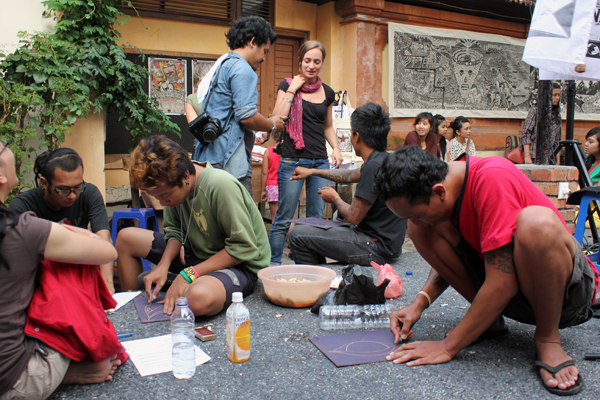 The process of making a wood cut starts by sketching a work of art on a medium-density fiberboard or block board. The art needs to be created as if it is horizontal reflection in a mirror, where right becomes left and left becomes right. After that, the illustration is carved, using small-edged razor blades or woodcut chisels. There are a number of different types of blades which produce different effects when carving the wood surface. The section of wood that is not carved is what will be printed on the artwork medium, and the carved section of wood makes sure that the medium does not touch the paint.
The process of making a wood cut starts by sketching a work of art on a medium-density fiberboard or block board. The art needs to be created as if it is horizontal reflection in a mirror, where right becomes left and left becomes right. After that, the illustration is carved, using small-edged razor blades or woodcut chisels. There are a number of different types of blades which produce different effects when carving the wood surface. The section of wood that is not carved is what will be printed on the artwork medium, and the carved section of wood makes sure that the medium does not touch the paint.
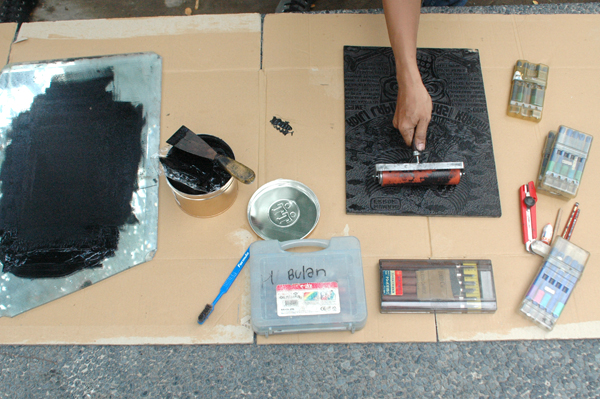 Once the woodcut is carved, paint is poured onto a flat, smooth surface, like a mirror. Then, the paint is smoothed out using a roller. The roller is then used to apply paint to the woodcut surface. Once the paint is evenly distributed, the woodcut is placed on top of the media in any position you like. The media should be placed on top of a flat surface, such as a flattened, used cardboard box.
Once the woodcut is carved, paint is poured onto a flat, smooth surface, like a mirror. Then, the paint is smoothed out using a roller. The roller is then used to apply paint to the woodcut surface. Once the paint is evenly distributed, the woodcut is placed on top of the media in any position you like. The media should be placed on top of a flat surface, such as a flattened, used cardboard box.
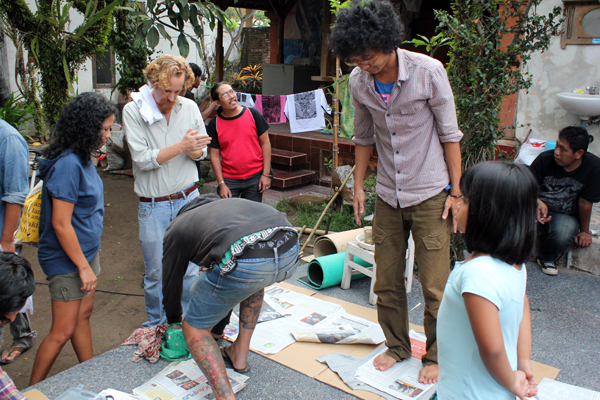 When placed on the surface to be printed, the backside of the woodcut should be covered with a piece of used paper to make sure that the medium does not get dirty. Then apply pressure to the wood cut until you think the paint is evenly distributed. Voila! Enjoy the surprise underneath: a work of woodcut art.
When placed on the surface to be printed, the backside of the woodcut should be covered with a piece of used paper to make sure that the medium does not get dirty. Then apply pressure to the wood cut until you think the paint is evenly distributed. Voila! Enjoy the surprise underneath: a work of woodcut art.










